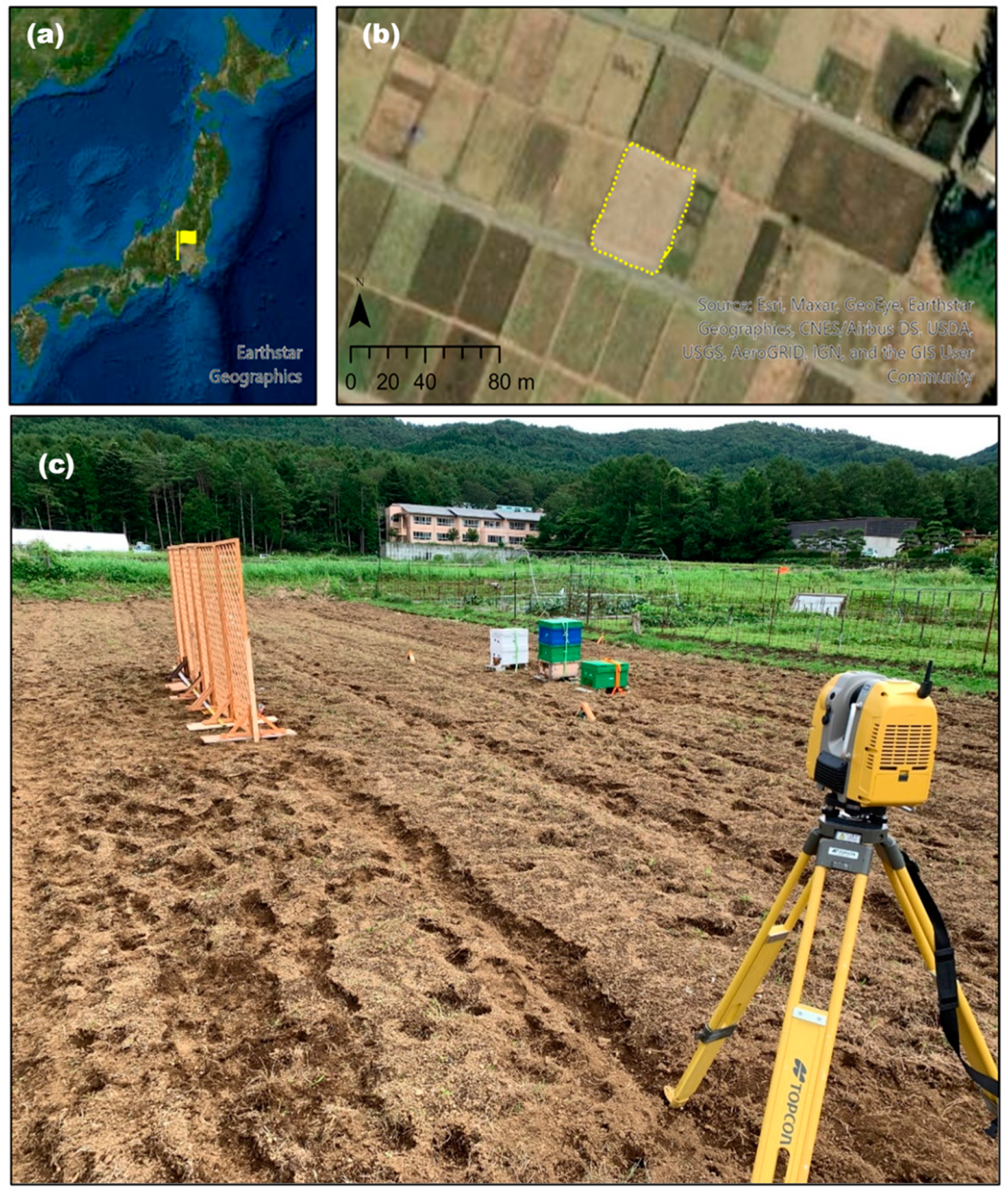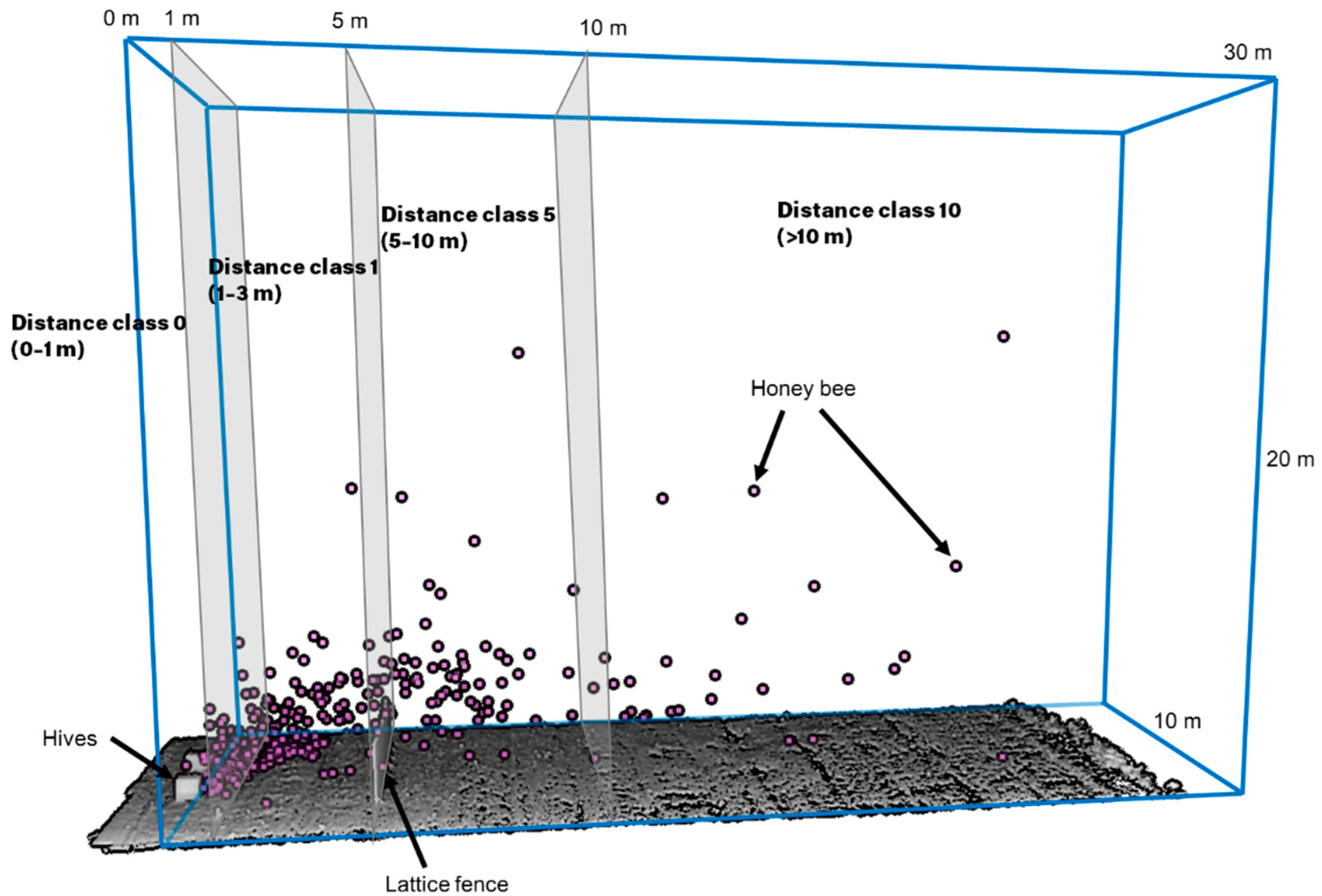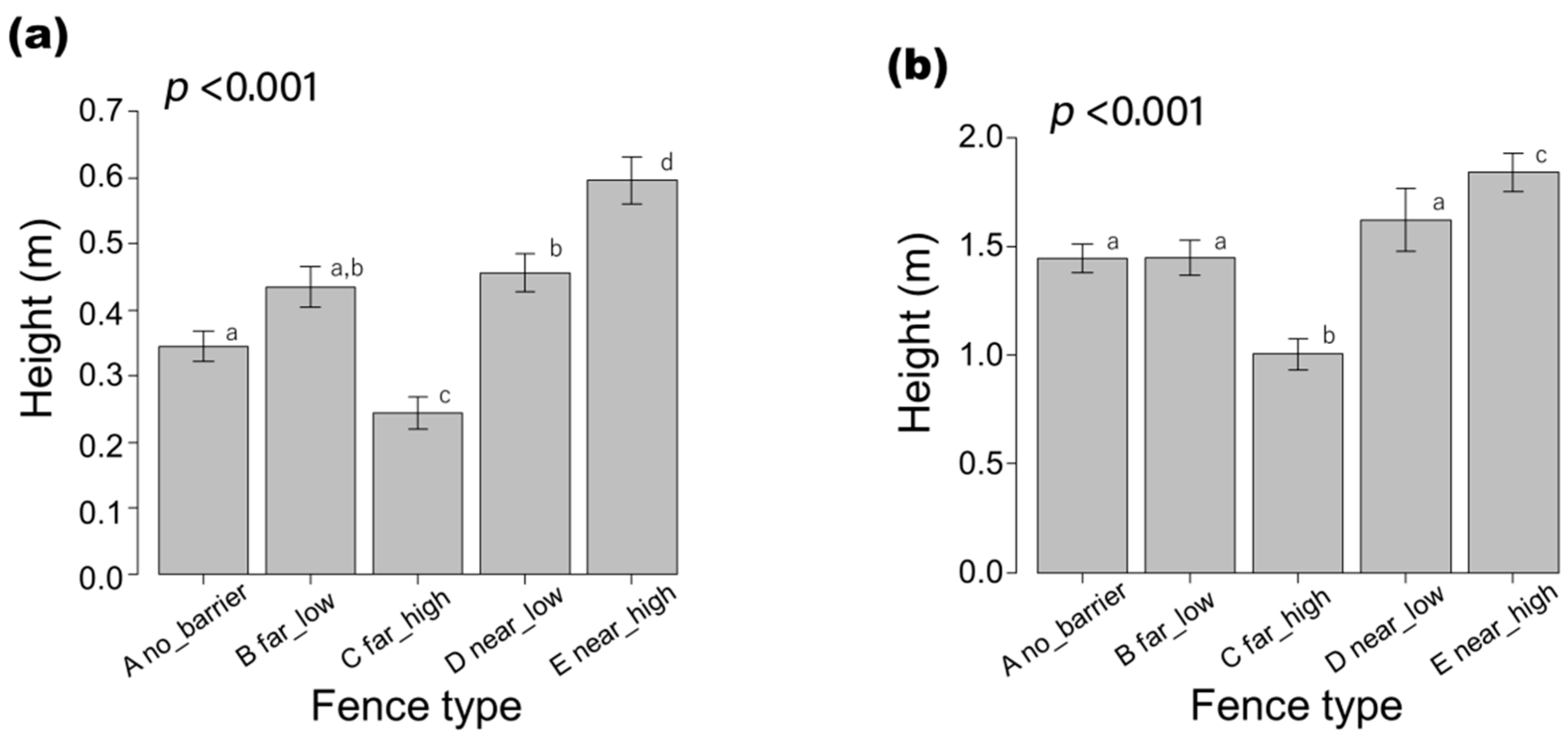Preliminary Experimental Trial of Effects of Lattice Fence Installation on Honey Bee Flight Height as Implications for Urban Beekeeping Regulations
Abstract
:1. Introduction
2. Materials and Methods
2.1. Study Area
2.2. Experimental Setup and Procedure
2.3. Measuring Flight Heights
2.4. Statistical Analyses
3. Results
4. Discussion
4.1. Effectiveness of the Barriers (Location and Height of the Lattice Fence)
4.2. Methodological and Management Implications
4.3. Limitations and Future Studies
Author Contributions
Funding
Institutional Review Board Statement
Informed Consent Statement
Data Availability Statement
Acknowledgments
Conflicts of Interest
References
- Ayan, S.; Ayan, Ö.; Altunel, T.; Yer, E.N. Honey forests as an example of agroforestry practices in Turkey. For. Ideas 2014, 20, 141–150. [Google Scholar]
- Bradbear, N. Bees and Their Role in Forest Livelihoods: A Guide to the Services Provided by Bees and the Sustainable Harvesting, Processing and Marketing of Their Products; Food and Agriculture Organization of the United Nations: Rome, Italy, 2009. [Google Scholar]
- IPBES. Summary for Policymakers of the Assessment Report of the Intergovernmental Science-Policy Platform on Biodiversity and Ecosystem Services (IPBES) on Pollinators, Pollination and Food Production. Available online: https://www.researchgate.net/publication/329503936_Summary_for_policymakers_of_the_assessment_report_of_the_Intergovernmental_Science-Policy_Platform_on_Biodiversity_and_Ecosystem_Services_IPBES_on_pollinators_pollination_and_food_production (accessed on 31 December 2019).
- Toni, C.; Djossa, B.; Yedomonhan, H.; Zannou, E.; Mensah, G. Western honey bee management for crop pollination. Afr. Crop. Sci. J. 2018, 26, 1–17. [Google Scholar] [CrossRef] [Green Version]
- Hoover, S.E.; Ovinge, L.P. Pollen Collection, Honey Production, and Pollination Services: Managing Honey Bees in an Agricultural Setting. J. Econ. Entomol. 2018, 111, 1509–1516. [Google Scholar] [CrossRef]
- Watson, K.; Stallins, J.A. Honey Bees and Colony Collapse Disorder: A Pluralistic Reframing. Geogr. Compass 2016, 10, 222–236. [Google Scholar] [CrossRef]
- Moore, L.J.; Kosut, M. Buzz: Urban Beekeeping and the Power of the Bee; New York University Press: New York, NY, USA, 2013. [Google Scholar]
- Henry, M.; Béguin, M.; Requier, F.; Rollin, O.; Odoux, J.-F.; Aupinel, P.; Aptel, J.; Tchamitchian, S.; Decourtye, A. A Common Pesticide Decreases Foraging Success and Survival in Honey Bees. Science 2012, 336, 348–350. [Google Scholar] [CrossRef]
- Askham, B. Urban buzz. Sanctuary Mod. Gr. Homes 2013, 25, 76–79. [Google Scholar]
- Egerer, M.; Kowarik, I. Confronting the Modern Gordian Knot of Urban Beekeeping. Trends Ecol. Evol. 2020, 35, 956–959. [Google Scholar] [CrossRef] [PubMed]
- Baldock, K. Opportunities and threats for pollinator conservation in global towns and cities. Curr. Opin. Insect Sci. 2020, 38, 63–71. [Google Scholar] [CrossRef]
- Skelton, J. Adventures in Urban Beekeeping. Briarpatch 2006, 35, 14–17. [Google Scholar]
- Wilk, B.; Rebollo, V.; Hanania, S. A Guide for Pollinator-Friendly Cities: How Can Spatial Planners and Land-Use Managers Create Favourable Urban Environments for Pollinators? Available online: https://www.iucn.org/sites/dev/files/local_authorities_guidance_document_en_compressed.pdf (accessed on 30 October 2021).
- City News Service Backyard Beekeeping OK’d by City of Los Angeles—Daily News. Available online: https://www.dailynews.com/2015/10/14/backyard-beekeeping-okd-by-city-of-los-angeles/ (accessed on 13 January 2020).
- Gallay, C. Beeware of the Consequences: The Importance of Urban Apiaries and Environmental ADR. Cardozo J. Confl. Resol. 2018, 20, 417–442. [Google Scholar]
- Salkin, P.E. Honey, It’s All the Buzz: Regulating Neighborhood Beehives. BC Envtl. Aff. L. Rev. 2012, 39, 55–71. [Google Scholar]
- Larson, K.L.; Andrade, R.; Nelson, K.C.; Wheeler, M.M.; Engebreston, J.M.; Hall, S.J.; Avolio, M.L.; Groffman, P.M.; Grove, M.; Heffernan, J.B.; et al. Municipal regulation of residential landscapes across US cities: Patterns and implications for landscape sustainability. J. Environ. Manag. 2020, 275, 111132. [Google Scholar] [CrossRef] [PubMed]
- Matsuzawa, T.; Kohsaka, R. Status and Trends of Urban Beekeeping Regulations: A Global Review. Earth 2021, 2, 933–942. [Google Scholar] [CrossRef]
- Garbuzov, M.; Ratnieks, F.L.W. Lattice fence and hedge barriers around an apiary increase honey bee flight height and decrease stings to people nearby. J. Apic. Res. 2014, 53, 67–74. [Google Scholar] [CrossRef] [Green Version]
- Reynolds, D.; Riley, J. Remote-sensing, telemetric and computer-based technologies for investigating insect movement: A survey of existing and potential techniques. Comput. Electron. Agric. 2002, 35, 271–307. [Google Scholar] [CrossRef]
- Smith, M.T.; Livingstone, M.; Comont, R. A method for low-cost, low-impact insect tracking using retroreflective tags. Methods Ecol. Evol. 2021, 12, 2184–2195. [Google Scholar] [CrossRef]
- Nunes-Silva, P.; Hrncir, M.; Guimarães, J.T.; Arruda, H.; Costa, L.; Pessin, G.; Siqueira, J.O.; de Souza, P.; Imperatriz-Fonseca, V.L. Applications of RFID technology on the study of bees. Insectes Sociaux 2019, 66, 15–24. [Google Scholar] [CrossRef]
- Tauc, M.J.; Fristrup, K.M.; Repasky, K.S.; Shaw, J.A. Field demonstration of a wing-beat modulation lidar for the 3D mapping of flying insects. OSA Contin. 2019, 2, 332–348. [Google Scholar] [CrossRef]
- Kanda, Y. Investigation of the freely available easy-to-use software ‘EZR’ for medical statistics. Bone Marrow Transplant. 2013, 48, 452–458. [Google Scholar] [CrossRef] [Green Version]
- Chen, Y.; Why, A.; Batista, G.; Mafra-Neto, A.; Keogh, E. Flying Insect Classification with Inexpensive Sensors. J. Insect Behav. 2014, 27, 657–677. [Google Scholar] [CrossRef] [Green Version]
- Matsuzawa, T.; Kohsaka, R.; Uchiyama, Y. Application of Environmental DNA: Honey Bee behavior and Ecosystems for Sustainable Beekeeping. In Modern Beekeeping-Bases for Sustainable Production; In Tech Open: Rijeka, Croatia, 2020. [Google Scholar] [CrossRef]
- Sponsler, D.B.; Bratman, E.Z. Beekeeping in, of or for the city? A socioecological perspective on urban apiculture. People Nat. 2021, 3, 550–559. [Google Scholar] [CrossRef]
- Nicholls, A.A.; Epstein, G.B.; Colla, S.R. Understanding public and stakeholder attitudes in pollinator conservation policy development. Environ. Sci. Policy 2020, 111, 27–34. [Google Scholar] [CrossRef]
- Uchiyama, Y.; Kohsaka, R. Application of the City Biodiversity Index to populated cities in Japan: Influence of the social and ecological characteristics on indicator-based management. Ecol. Indic. 2019, 106, 105420. [Google Scholar] [CrossRef]
- Shih, W.-Y.; Mabon, L.; de Oliveira, J.A.P. Assessing governance challenges of local biodiversity and ecosystem services: Barriers identified by the expert community. L. Use Policy 2020, 91, 104291. [Google Scholar] [CrossRef]
- Uchiyama, Y.; Kohsaka, R. Strategies of Destination Management Organizations in Urban and Rural Areas: Using Text Analysis Method for SWOT Descriptions at Meta-level. Int. J. Hosp. Tour. Adm. 2021, 1, 1–19. [Google Scholar] [CrossRef]
- Quevedo, J.M.D.; Uchiyama, Y.; Kohsaka, R. Linking blue carbon ecosystems with sustainable tourism: Dichotomy of urban–rural local perspectives from the Philippines. Reg. Stud. Mar. Sci. 2021, 45, 101820. [Google Scholar] [CrossRef]
- Imai, H.; Nakashizuka, T.; Kohsaka, R. An analysis of 15 years of trends in children’s connection with nature and its relationship with residential environment. Ecosyst. Health Sustain. 2018, 4, 177–187. [Google Scholar] [CrossRef]
- Kohsaka, R.; Park, M.S.; Uchiyama, Y. Beekeeping and honey production in Japan and South Korea: Past and present. J. Ethn. Foods 2017, 4, 72–79. [Google Scholar] [CrossRef]
- Quevedo, J.M.D.; Uchiyama, Y.; Kohsaka, R. A blue carbon ecosystems qualitative assessment applying the DPSIR framework: Local perspective of global benefits and contributions. Mar. Policy 2021, 128, 104462. [Google Scholar] [CrossRef]
- Kohsaka, R. Developing biodiversity indicators for cities: Applying the DPSIR model to Nagoya and integrating social and ecological aspects. Ecol. Res. 2010, 25, 925–936. [Google Scholar] [CrossRef]





| Fence Type | Distance from Hives | Height of Barrier | Experimental Sequence and Time |
|---|---|---|---|
| A | None | None | 1st (7:34–) |
| B | Far (5 m) | Low (0.9 m) | 2nd (8:46–) |
| C | Far (5 m) | High (1.8 m) | 3rd (9:52–) |
| D | Near (1 m) | Low (0.9 m) | 4th (11:15–) |
| E | Near (1 m) | High (1.8 m) | 5th (12:20–) |
| Scientific Name | Body Size (mm) | Number of Individuals (%) |
|---|---|---|
| Apis mellifera | 12–14 | 13 (72%) |
| Vespa simillima | 22 | 1 (5.6%) |
| Psilopa polita | 2 | 1 (5.6%) |
| Phoridae gen. sp. | 1 | 1 (5.6%) |
| Drosophilidae gen. sp. | 1 | 1 (5.6%) |
| Aphididae gen. sp. | 1 | 1 (5.6%) |
| Fence Type | Height and Distance | Number of Honey Bee Plots | Number of Honey Bee Plots in the Analysis Space (W 10 m × L 30 m × H 20 m) |
|---|---|---|---|
| A | No barrier | 2007 | 845 |
| B | Far–Low | 3004 | 752 |
| C | Far–High | 1190 | 634 |
| D | Near–Low | 1099 | 633 |
| E | Near–High | 1329 | 671 |
| Total | - | 8629 | 3535 |
Publisher’s Note: MDPI stays neutral with regard to jurisdictional claims in published maps and institutional affiliations. |
© 2021 by the authors. Licensee MDPI, Basel, Switzerland. This article is an open access article distributed under the terms and conditions of the Creative Commons Attribution (CC BY) license (https://creativecommons.org/licenses/by/4.0/).
Share and Cite
Matsuzawa, T.; Kohsaka, R. Preliminary Experimental Trial of Effects of Lattice Fence Installation on Honey Bee Flight Height as Implications for Urban Beekeeping Regulations. Land 2022, 11, 19. https://doi.org/10.3390/land11010019
Matsuzawa T, Kohsaka R. Preliminary Experimental Trial of Effects of Lattice Fence Installation on Honey Bee Flight Height as Implications for Urban Beekeeping Regulations. Land. 2022; 11(1):19. https://doi.org/10.3390/land11010019
Chicago/Turabian StyleMatsuzawa, Tomonori, and Ryo Kohsaka. 2022. "Preliminary Experimental Trial of Effects of Lattice Fence Installation on Honey Bee Flight Height as Implications for Urban Beekeeping Regulations" Land 11, no. 1: 19. https://doi.org/10.3390/land11010019
APA StyleMatsuzawa, T., & Kohsaka, R. (2022). Preliminary Experimental Trial of Effects of Lattice Fence Installation on Honey Bee Flight Height as Implications for Urban Beekeeping Regulations. Land, 11(1), 19. https://doi.org/10.3390/land11010019







